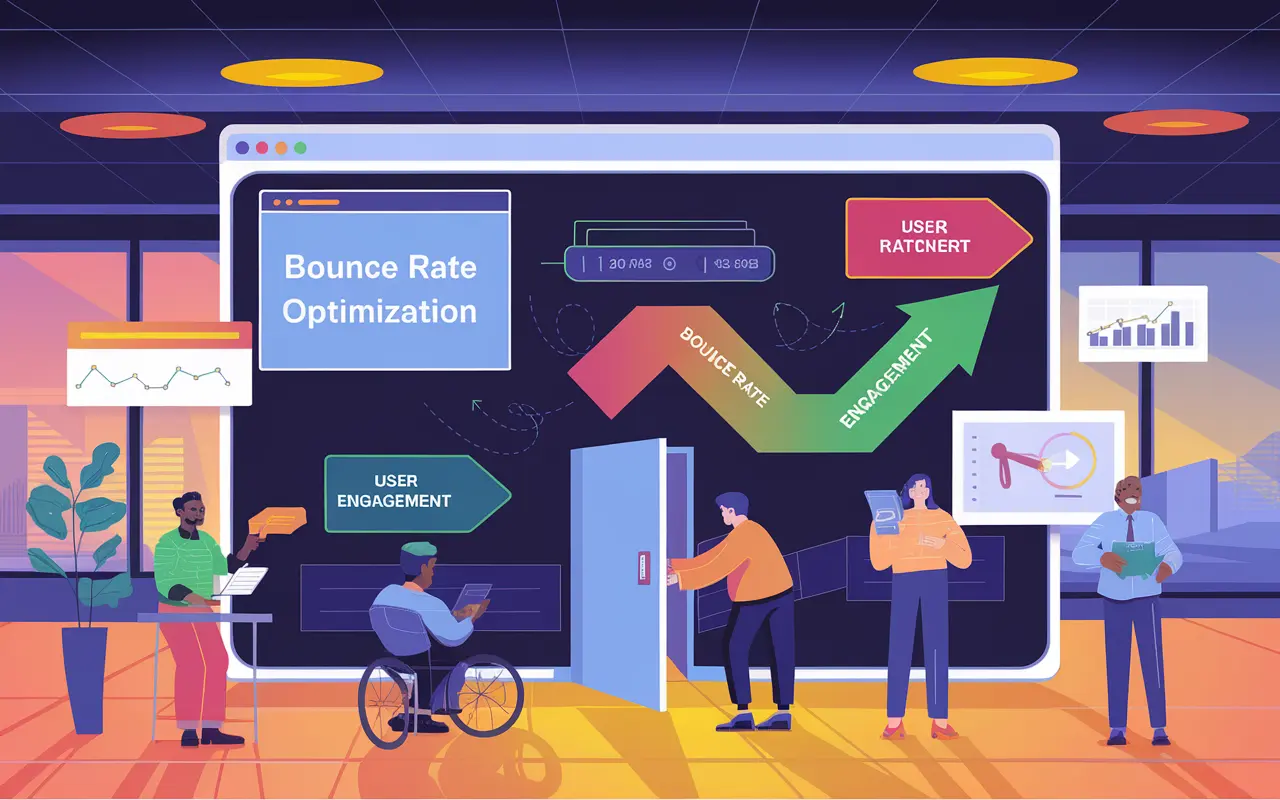Understanding Bounce Rate Optimization in SEO
Bounce Rate Optimization refers to the strategic efforts made to reduce the number of visitors who leave a website after viewing only one page. It is a critical subset of user experience (UX) and conversion rate optimization (CRO), designed to keep users engaged, decrease exit rates, and encourage deeper interactions within your site.
High bounce rates often indicate issues with content relevance, poor user interface, technical problems, or slow loading. Optimizing your bounce rate is essential to enhance usability, keep visitors longer on your site, and signal to search engines like Google that your content is valuable and engaging—positively influencing SEO rankings and business conversion goals.
Key Takeaway
Key Takeaway
Bounce Rate Optimization improves SEO by keeping users engaged on your site longer, signaling content relevance to search engines and boosting organic rankings.
Why Bounce Rate Optimization Matters for SEO Success
Optimizing bounce rates is essential for improving visibility, rankings, and user satisfaction. Search engines prioritize pages that offer a satisfying experience, and a high bounce rate often correlates with poor engagement signals. Google may interpret a high bounce rate as a negative user experience, reducing the authority of the page in search results.
For businesses, this directly translates into:
- Increased lead generation
- Improved customer retention
- Higher conversion paths
- Stronger brand trust and longer sessions
Learn more about how Bounce Rate Optimization enhances your overall SEO strategy.
Best Practices for Bounce Rate Optimization
- Improve Page Load Speed: Use tools like Google PageSpeed Insights or GTmetrix to identify and fix latency issues. Compress images, enable browser caching, and use a content delivery network (CDN).
- Enhance Mobile Responsiveness: Make sure your site is responsive on all devices. Google favors mobile-first indexing, and poor mobile UX directly impacts bounce rate.
- Craft Compelling and Relevant Content: Ensure that content aligns with user intent. Use headers, visuals, and concise explanations to draw readers deeper into the page.
- Use Clear Navigation & Internal Linking: Guide users with intuitive menus and strategic internal links to reduce single-page sessions.
- Include CTAs & Interactive Elements Above the Fold: Use eye-catching CTAs early to drive engagement within seconds of landing.
- Use Heatmaps & Analytics: Study user behavior using Hotjar or Crazy Egg to see where users drop off, scroll, and click for data-informed decisions.
How Bounce Rate Optimization Works to Improve SEO Outcomes
Reducing bounce rate involves enhancing usability and relevance to align with user expectations. Here’s how it works:
Analyzing Behavior Metrics
Tools like Google Analytics track pages with high bounce rates. Understanding source traffic, top-exit pages, and dwell time helps identify problem areas.
Implementing UX, Content & Speed Improvements
SEO professionals then fine-tune content, user interfaces, loading times, and internal links. This not only keeps users engaged but assures search engines that your content offers genuine value.
SEO Signals from Engagement
Lower bounce rates increase dwell time and pages per session—that’s strong behavioral signals for Google. It helps improve organic rankings significantly.
| Metric | Before Optimization | After Optimization |
|---|---|---|
| Bounce Rate | 78% | 48% |
| Average Session Duration | 00:42 sec | 02:14 min |
| Pages per Session | 1.2 | 3.3 |
| Organic Traffic | +0% | +65% |
Case Study: How Reducing Bounce Rate Skyrocketed Engagement Metrics
Problem: High Bounce Rate Hindering Organic Rankings
A mid-sized ecommerce site had a 76% bounce rate on its landing pages, causing stagnant rankings and low visitor-to-customer conversions.
Solution: UX Overhaul and Content Refresh Strategy
The team redesigned the navigation structure, implemented responsive design across devices, improved loading speeds, and optimized content with intent-focused CTAs and multimedia storytelling.
Results: Bounce Rate Dropped, Engagement Increased
Bounce rate reduced to 43% within three months. The average session length increased by 115%, and organic traffic grew by 72%—leading to a 31% sales uplift.
Common Mistakes to Avoid in Bounce Rate Optimization
- Overloading Pages with Ads: Intrusive ads create friction and abandon-triggering experiences.
- Misleading Meta Descriptions: If users don’t find what was promised on the SERP, they’ll bounce fast.
- Lack of Visual Hierarchy: Unreadable fonts, big blocks of text, and unclear CTAs harm engagement.
- Ignoring Mobile Optimization: Unscrollable layouts alienate up to 60% of mobile users.
Related SEO Terms
Explore connected terms that help reduce bounce rate and enhance user experience:
- User Experience (UX): Designing for seamless navigation and satisfaction improves time-on-site.
- Page Speed: Faster-loading pages reduce friction and drop-offs tremendously.
- Dwell Time: The average duration a user stays on a page—often enhanced via bounce rate optimization.
FAQs About Bounce Rate Optimization
A bounce rate between 40% and 55% is considered average. Rates under 40% are excellent and indicate highly engaging content or design.
Google uses user engagement signals like bounce rate to determine page value. High bounce rates may signal low relevance or usability, affecting rankings negatively.
If designed well, exit-intent pop-ups can retain visitors or convert them by offering value. Poorly designed ones might increase exits, however.
Yes, visitors who bounce often have very low session durations. The longer a visitor stays, the more likely they are to view multiple pages.
Conclusion: Make Bounce Rate Optimization Core to Your SEO Strategy
Bounce Rate Optimization is more than CRO—it’s a critical SEO signal that speaks volumes about your website’s user value. By reducing bounce rates, you not only improve rankings but elevate user experience, grow conversions, and increase retention. Integrating Bounce Rate Optimization into your strategic SEO roadmap ensures better performance, higher ROI, and exceptional user satisfaction.
Explore more SEO best practices by visiting our SEO learning hub.






